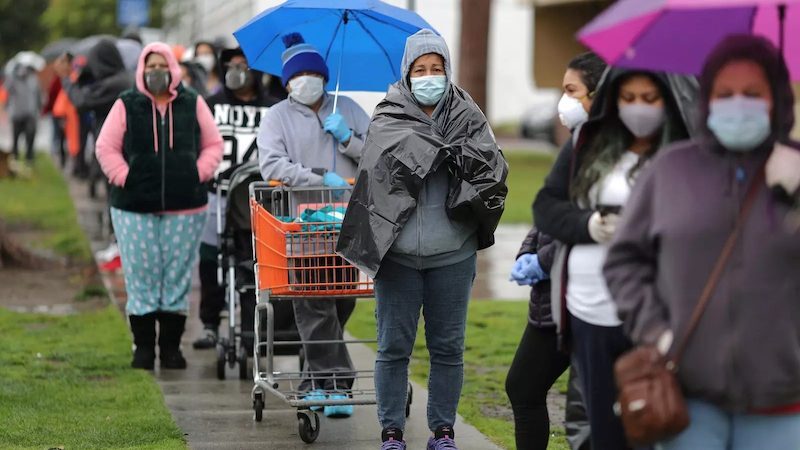The rise in food insecurity — lacking enough food to live a healthy, active life — comes as the nation has ended the pandemic emergency and the economy, by many measures, continues to be strong. The unemployment rate is near a 50-year low, while wages have been rising for many workers.
Comment: Even before the food crisis, the corruption of America's food supply had already helped turn it into one of the sickest nations on the planet. As for unemployment and wages, evidently the data proclaimed above has been twisted to push the establishment narrative, however, as this article shows, the truth of the dire situation is becoming nigh on impossible to deny: US jobless claims still sunk at 52-year low with just 206,000 new claims, labour participation at record lows
But those figures hide a stark reality that's affecting a growing share of U.S. households, ranging from young families to older Americans. Although jobs are plentiful, many employees don't earn enough to cover the surging cost of living, pushing some to make tradeoffs like skipping meals.
And cuts to the food-stamp program earlier this year reduced benefits at a time when groceries are 20% costlier than two years ago. That caused food insecurity to jump to "unprecedented levels" in May among food-stamp recipients, according to a new survey from Propel, which makes an app for beneficiaries to check balances for the Supplemental Nutrition Assistance Program, or SNAP, (formerly known as food stamps).
About 44% of respondents reported skipping meals in the last month, a 7% increase and a record high, Propel noted. Those findings were echoed in a new study from the Greater Boston Food Bank, which found that some local families are making desperate choices, such as watering down baby formula or other food.
"When I see one in three households with children reporting that their children were hungry, or they skipped a meal, that shouldn't happen," said Catherine D'Amato, CEO of the Greater Boston Food Bank, told CBS MoneyWatch. "This shows this is a hunger crisis that is persisting in Massachusetts."
D'Amato said that current rates of food insecurity are the highest she has ever seen in her career. Her group's study, released Tuesday, found that 33% of Massachusetts households were food insecure in 2022, while 36% of those with children didn't have enough food last year.
The research jibes with findings from the U.S. Census, which for three years has asked households about their food consumption. The number of Americans who say they sometimes don't have enough to eat has jumped 23% — from 15.8 million prior to the pandemic to 19.2 million in the most recent survey, taken in late April and early May.
New food-stamp work requirements
The rise in food insecurity comes as the debt ceiling deal, struck between the White House and Republican lawmakers, would add more work requirements to SNAP. That could create more hardship for a greater number of struggling Americans, D'Amato predicted.
"The SNAP cuts and the work requirements are really going to be harmful," she added. "We don't know to what extent until we see the final debt ceiling agreements and how it gets rolled out."
SNAP already includes work requirements for low-income people ages 18 to 49 who are able-bodied and without dependents. Under the deal, that age limit would be raised to 54 years old, which could hurt older workers without a stable income and potentially put them at risk of losing food aid, experts said.
Comment: Forcing people into jobs that pay poverty wages.
However, the deal would temporarily eliminate SNAP work requirements for veterans and those experiencing homelessness, regardless of age.
Comment: Which will actually encourage some to choose homelessness.
Those exceptions, as well as the higher age limit for work requirements, would expire in 2030.
About 700,000 people between the ages of 50 to 54 would be impacted by the new work requirements, according to the Wall Street Journal. But by eliminating work requirements for veterans and homeless people, about 78,000 people would gain benefits each month, the Congressional Budget Office said in a Tuesday report.
Together, the changes to SNAP would boost government spending by $2.1 billion over the next decade, the CBO estimated.
Comment: In just one year the US government has given Ukraine tens of billions for its proxy-war on Ukraine.
Tradeoffs: Groceries or rent?
In the meantime, low-income Americans are increasingly making tradeoffs and experiencing broader hardships as they cope with the rising cost of groceries and cuts to their food aid, research shows. Eviction rates for food-stamp recipients soared by 40% from April to May, while 11% of respondents had their utilities cut off in the last month, a 24% jump from the prior month, Propel found.
A majority of households in Massachusetts who experienced food insecurity last year reporting having to decide between paying for food or covering rent, utilities and other costs, the Greater Boston Food Bank found. And almost one-third said they had watered down food or infant formula to make ends meet, while 85% said they bought the cheapest food available.
"You hear this in health care, that 'I skipped my medication for a day'," but now people are making these same choices with food, D'Amato said. "It's shocking, though not surprising, that families are in a situation where they have to make tradeoffs."




Haha usa has turned into china right before our eyes.